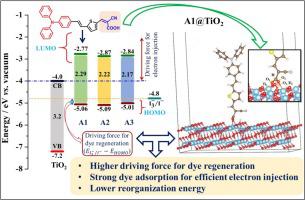Journal of Photochemistry and Photobiology A: Chemistry ( IF 4.1 ) Pub Date : 2020-07-03 , DOI: 10.1016/j.jphotochem.2020.112745 Sudip Mandal , Ganapathi Rao Kandregula , Venkata Naga Baji Tokala

|
Five metal-free organic dyes (A1 to A5) comprising triphenylamine and vinyl-thiophene as a common donor and spacer, respectively were considered in this work. The different acceptors, such as 2-cyanoacetic acid, 2-methylenemalononitrile, rhodanine-3-acetic acid, benzoic acid, and pyridine were chosen to investigate their accepting ability, photovoltaic performances, and adsorption onto the TiO2 surface. Density functional theory (DFT) and time-dependent DFT were employed to study their photophysical and photoelectrochemical properties. The ground state energies were calculated to evaluate the dye regeneration driving force (). The excited-state calculation provided the information about the intramolecular charge transfer (ICT) and excited-state properties. Projected density of state and natural bond orbital (NBO) analyses were carried out to further understand the ICT between triphenylamine donor and the acceptor moiety. The density of states of the [email protected]2 revealed the smooth electron transfer at the dye/TiO2 interface devoid of defect state. Higher (), highest negative NBO charge on the acceptor, lower reorganization energy, and higher negative adsorption energy onto the surface of the TiO2 would make the dye A1 as the best performer in DSSC. The computed data are in good agreement with the experimental observation.
中文翻译:

在DSSC应用中,三苯胺基染料中受主基团对光电性能和TiO 2表面吸附的影响的计算研究
在这项工作中,分别考虑了五种不含金属的有机染料(A1-A5),它们分别包含三苯胺和乙烯基噻吩。选择不同的受体,例如2-氰基乙酸,2-亚甲基丙二腈,若丹宁-3-乙酸,苯甲酸和吡啶,以研究它们的接受能力,光电性能以及在TiO 2表面上的吸附。利用密度泛函理论(DFT)和时间依赖的DFT来研究它们的光物理和光电化学特性。计算基态能量以评估染料再生驱动力()。激发态计算提供了有关分子内电荷转移(ICT)和激发态性质的信息。对状态和自然键轨道(NBO)进行了预测密度分析,以进一步了解三苯胺供体与受体部分之间的ICT。[受电子邮件保护的] 2的状态密度表明,在染料/ TiO 2界面上的电子平稳转移,没有缺陷状态。更高(),受体上的NBO负电荷最高,重组能较低,在TiO 2表面上具有较高的负吸附能,将使染料A1在DSSC中表现最佳。计算结果与实验结果吻合良好。











































 京公网安备 11010802027423号
京公网安备 11010802027423号